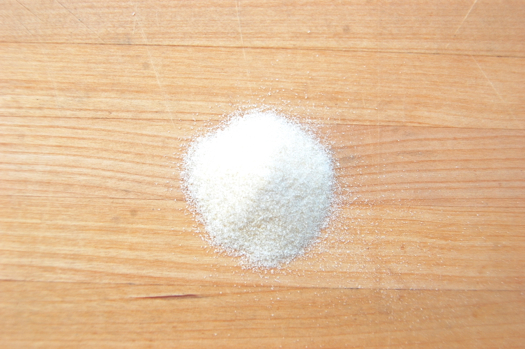Gelatin

Gelatin is a protein, one that’s derived from a very interesting material called collagen. If you were to think of an animal’s body like a machine, where the bones and joints are the moving parts and the muscles are the motors, collagen is the rope and cabling that connects it all together. In fact collagen molecules are constructed very much like rope: three long protein molecules (individually known as gelatins) woven around each other to form a tight triple-helix. They’re very strong, the perfect material for making things like tendons and other so-called “connective” tissues.
The unique thing about collagen is that the gelatin proteins that make it up are bound to each other only very weakly. Immerse them in water and apply a little heat and the chemical bonds break, causing the collagen rope to unwind and the individual gelatin molecules to separate. As this mixture of protein molecules and liquid starts to cool, the molecules once again become attracted to one another. But having once uncoiled they can’t wind themselves back into rope-like structures again. The result is a loose tangle of long, string-like molecules that functions much like a net which keeps water molecules from flowing. The results is a gel, an you can create one, albeit a loose one, in a mixture with as little as 1% gelatin.
What makes gelatin unique in the thickening world — and indeed the protein world — is that it can be re-heated, re-melted and re-set over and over again again. Unlike all the other proteins in the kitchen, which when heated uncoil and then slowly clench back up into irreversible knots, gelatin molecules are only too happy to release and re-form their weak bonds over and over again when circumstances require it. In the pastry kitchen circumstances frequently do, which is what makes gelatin such an indispensable item in any pantry.
Powdered gelatin is the most common form of the stuff in the states, sheets or “leaves” are popular in other parts of the world. Using either requires rehydrating the gelatin with cold water, then melting it (rehydrated gelatin melts at about 95 degrees Fahrenheit).
Liquids thickened with gelatin generally yield glossy, clear gels with no grainy mouthfeel. This is due to the very small size of the gelatin molecules, which don’t register on the tongue and which are positioned far enough from each other in the gel such that light rays easily pass through, the result being clarity.
Are we getting ready to breach the subject of hydrocolloids??? I ask gleefully!
Most thickeners are hydrocolloids as far as I know Dave! Cornstarch, gelatin, flour…but I assume you’re talking about things like xanthan gum, right? I’ll happily incorporate a few!
Cheers,
– Joe
Indeed! Xanthan, locust bean, agar, the carageenan suite, maltodextrin. Anything of the sort has always been fascinating to me. I have done some research but have yet to find some great concise, thorough, as you most definitely provide, definitions and uses. Seems they really only use these things in Europe and haute cuisine type places here in u.s. ‘preesh if you can touch base. Thanks!
I’ll do my best, DiD!
– Joe
Have you ever worked with agar? I have a vegan friend and she won’t eat any gelled things unless its made with agar. I have seen it in the Asian market but never cooked with it & wonder if it requires any special consideration.
I have and I like it. It has some different strengths and weaknesses which I shall get into!
Cheers,
– Joe
THANKS!